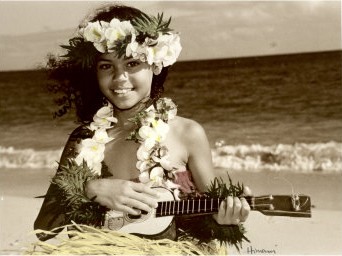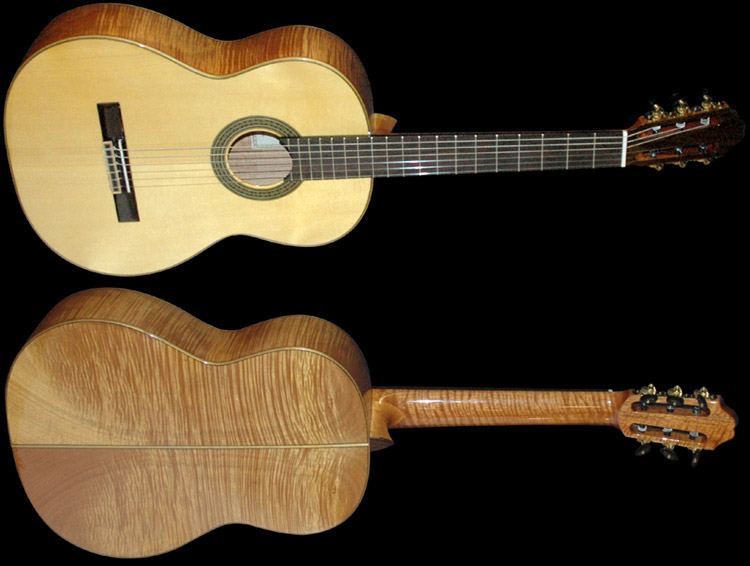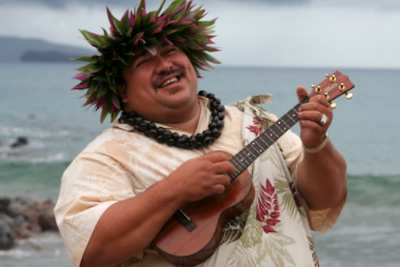History
Hawai
Ukuleles are commonly associated with music from Hawaii where the name roughly translates as "jumping flea,"[4] perhaps due to movement of the player's fingers. Legend attributes it to the nickname of Englishman Edward William Purvis, one of King Kalakaua's officers, due to his small size, fidgety manner, and playing expertise. According to Queen Lili?uokalani, the last Hawaiian monarch, the name means “the gift that came here,” from the Hawaiian words uku (gift or reward) and lele (to come). Developed in the 1880s, the ukulele is based on two small guitar-like instruments of Portuguese origin, the cavaquinho and the rajao, introduced to the Hawaiian Islands by Portuguese immigrants from Madeira and Cape Verde.[5] Three immigrants in particular, Madeiran cabinet makers Manuel Nunes, José do Espírito Santo, and Augusto Dias, are generally credited as the first ukulele makers.[6] Two weeks after they disembarked from the SS Ravenscrag in late August 1879, the Hawaiian Gazette reported that "Madeira Islanders recently arrived here, have been delighting the people with nightly street concerts."[7] One of the most important factors in establishing the ukulele in Hawaiian music and culture was the ardent support and promotion of the instrument by King Kalakaua. A patron of the arts, he incorporated it into performances at royal gatherings.
Canada
In the 1960s, educator J. Chalmers Doane dramatically changed school music programs across Canada, using the ukulele as an inexpensive and practical teaching instrument to foster musical literacy in the classroom.[9] 50,000 schoolchildren and adults learned ukulele through the Doane program at its peak.
Japan
The ukulele came to Japan in 1929 after Hawaiian-born Yukihiko Haida returned to the country upon his father's death and introduced the instrument. Haida and his brother Katsuhiko formed the Moana Glee Club, enjoying rapid success in an environment of growing enthusiasm for Western popular music, particularly Hawaiian and jazz. During World War II, authorities banned most Western music, but fans and players kept it alive in secret, and it resumed popularity after the war. In 1959, Haida founded the Nihon Ukulele Association. Today, Japan is considered a second home for Hawaiian musicians and ukulele virtuosos.
United Kingdom
The singer and comedian George Formby was perhaps the UK's most famous ukulele player, though he often played a banjolele, a hybrid instrument consisting of an extended ukulele neck with a banjo resonator body. Demand surged in the new century due to its relative simplicity and portability.
United States
The ukulele was popularized for a stateside audience during the Panama Pacific International Exposition, held from spring to fall of 1915 in San Francisco.[13] The Hawaiian Pavilion featured a guitar and ukulele ensemble, George E. K. Awai and his Royal Hawaiian Quartet,[14] along with ukulele maker and player Jonah Kumalae.[15] The popularity of the ensemble with visitors launched a fad for Hawaiian-themed songs among Tin Pan Alley songwriters.[16] The ensemble also introduced both the lap steel guitar and the ukulele into U.S. mainland popular music,[17] where it was taken up by vaudeville performers such as Roy Smeck and Cliff "Ukulele Ike" Edwards. On April 15, 1923 at the Rivoli Theater in New York City, Smeck appeared, playing the ukulele, in Stringed Harmony, a short film made in the DeForest Phonofilm sound-on-film process. On August 6, 1926, Smeck appeared playing the ukulele in a short film His Pastimes, made in the Vitaphone sound-on-disc process, shown with the feature film Don Juan starring John Barrymore The ukulele soon became an icon of the Jazz Age.[19] Highly portable and relatively inexpensive, it also proved popular with amateur players throughout the 1920s, as is evidenced by the introduction of uke chord tablature into the published sheet music for popular songs of the time,[19] a role that would eventually be supplanted by the guitar in the early years of rock and roll.[20] A number of mainland-based instrument manufacturers, among them Regal, Harmony, and Martin, added ukulele, banjolele, and tiple lines to their production to take advantage of the demand. The ukulele also made inroads into early country music or Old-time music.[21] It was played by Jimmie Rodgers and Ernest V. Stoneman, as well as by early string bands, including Cowan Powers and his Family Band, Da Costa Woltz's Southern Broadcasters, Walter Smith and Friends, The Blankenship Family, The Hillbillies, and The Hilltop Singers.
From the late 1940s to the late 1960s, plastics manufacturer Mario Maccaferri turned out about 9 million inexpensive ukuleles.[22] The ukulele continued to be popular, appearing on many jazz songs throughout the 1950s, 1960s, and 1970s.[23] Much of the instrument's popularity was cultivated via The Arthur Godfrey Show on television.[24] Singer-musician Tiny Tim became closely associated with the instrument after playing it on his 1968 hit "Tiptoe Through the Tulips."
After the 1960s, the ukulele declined in popularity until the late 1990s, when interest in the instrument reappeared.[25] During the 1990s, new manufacturers began producing ukuleles and a new generation of musicians took up the instrument. Hawaiian musician Israel Kamakawiwo'ole helped re-popularise the instrument, in particular due to his 2003 medley of "Over the Rainbow" and "What a Wonderful World," used in films, television programs, and commercials. The song reached #12 on Billboard's Hot Digital Tracks chart the week of January 31, 2004 (for the survey week ending January 18, 2004).



